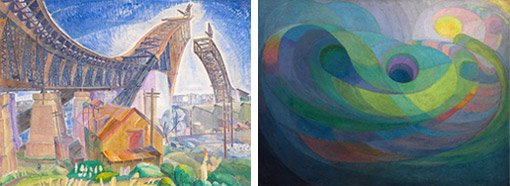We found the time in our busy schedules of good works to go to the Art Gallery of New South Wales to see ‘Sydney Moderns: Art for the New World.’ The items ranged from 1909 to 1947, spanning both the World Wars.
It was well worth the visit to see the works gathered and to follow the narrative in which they were placed. In this case ‘modern’ seems at the outset primarily to have meant the dominance of colour over content. Several of the themes in the exhibition explored colour. Regrettably the pastels made me think of the 1980s.
The reference point for the moderns was the Sydney Harbour Bridge, because it dwarfed all else in the city (and the country) and represented, in their minds at least, the triumph of modern engineering over the natural barrier of the harbour.
But as we traveled through the exhibit ‘the modern’ took on other meanings, specific examples include the inclusion of machinery in art with painting of factories, train stations, automobiles. It also meant modern life which became in the period covered decidedly urban. Urban life meant apartment buildings higher than before, it meant crowds on the street, and it meant – those beloved temples of commerce – department stores capitalizing on the critical mass of consumers in cities. More generally, the modern also meant breaking with the artistic conventions of the past and so included Margaret Preston’s still-lifes and her experiments with Aboriginal motifs.
It was refreshing to see that the loose groups of Sydney modernists also embraced commerce and strove for decorative features in their works to sell to users, not just collectors, but users. In this respect the role of the magazine HOME was emphasized, and its pages were also open to photographs as a modern art form as well as the design of furniture.

We saw an exhibition last year or earlier of German art between the wars, Weimar, and it most of its works were dark, brooding, sharp-edged, and out of control. They portrayed a world teetering on the brink of a black abyss, even in the style of coffee cups! Quite a contrast. Sydney Moderns is on the whole optimistic and happy with the world.
While comparing it to the other efforts, a lot of this was going on when Castlecrag was developed but I saw no sign of interaction with it.
The narrative in this very well curated exhibition also makes clear the community of artists who cooperated, competed, and learned from each other. And those that sold decorative works seemed to have made a good living from it. Not the singular, starving artist of the garrett much loved in melodramas.
Skip to content
